Original Title: "IOSG|Binance Listing Path Research: Alpha, IDO, Futures, Spot All Dissected"
Original Author: Xinyang, IOSG Ventures
TL;DR:
This study analyzes the token lifecycle performance of Binance's four major listing channels—Alpha, IDO, Futures, and Spot—and tracks their subsequent listings on Bitget, Bybit, Coinbase, and Upbit, focusing on return performance, listing rhythm, track preferences, and FDV ranges.
Performance Review
· The median 14-day FDV for most channels is negative, reflecting that most projects reach their valuation peak upon listing;
· Binance Alpha shows the most explosive performance (average 220%), but with high volatility;
· Binance IDO has a well-balanced short-term increase and a high conversion rate (to Futures and Spot);
· Binance Spot has the weakest short-term performance, possibly due to being an exit point for early investors;
· Bitget and Coinbase perform well in the secondary market, while Bybit and Upbit are relatively average.
Platform Selection by FDV Range
· Binance Spot prefers large-cap projects (>$500M);
· Alpha mainly supports early projects around $200M, suitable for testing the waters;
· IDO focuses on medium-sized projects in the $70M–$200M range;
· Bitget / Bybit have flexible ranges but lean towards projects with growth potential or large market caps;
· Coinbase / Upbit prefer projects with strong compliance and high valuations.
Expected Listing Times
· Alpha → Spot: approximately 60 days on average;
· IDO → Spot: approximately 17 days on average;
· Futures → Spot: only about 14 days on average;
· Futures may be the fastest channel.
Track Preferences
· Alpha: prefers Meme, AI;
· IDO: prefers Infra, AI;
· Spot: covers Infra, Meme, AI;
· Futures: broader, focusing on Infra, AI, Meme;
· Project teams can choose the appropriate listing method based on their narrative direction.
Advanced Listing Paths
· Alpha → Futures: conversion rate 37.8%
· Alpha → Spot: conversion rate 12.2%
· IDO → Futures: conversion rate 66.7%
· IDO → Spot: conversion rate 23.8%
· Achieving about a 40% increase in FDV is a common characteristic for entering the next stage platform.
Alternative Platform Performance
· Bitget is the most accommodating alternative CEX, especially friendly to Alpha/IDO projects;
· Bybit also shows a high willingness to accommodate IDO projects;
· Coinbase / Upbit list very few projects, with strict reviews and longer cycles.
This study focuses on the lifecycle performance of project tokens listed through Binance channels (Alpha, commonly referred to as IDO by the community, Futures, and Spot) and tracks these projects' subsequent listing paths on centralized exchanges (CEX) such as Bitget, Bybit, Upbit, and Coinbase. The analysis covers token return performance, listing timing, project track preferences, and valuation distribution (FDV dynamics), aiming to provide strategic listing path recommendations for project teams and establish a data-driven price discovery and trading strategy evaluation framework for investors.
Terminology Explanation: What do Binance's Spot / Futures / IDO / Alpha listings refer to?
· Binance Spot is Binance's most basic trading platform, where users can buy or sell tokens at the current market price, completing asset delivery once a transaction is made, allowing for free holding, transfer, or sale.
· Binance Futures provides crypto derivatives trading services, allowing users to go long or short and use leverage to amplify gains or losses.
· Binance IDO is a public offering channel for retail users, where users participate in new projects' token issuance on the BNB chain by staking BNB or completing tasks set by the Binance team in the Alpha Quest, usually occurring before the token officially lists on other platforms.
· Binance Alpha is a project discovery platform launched by Binance, integrating Pancakeswap and other on-chain DEXs on the BNB Chain, supporting early-stage projects with growth potential, emphasizing experimentation and token diversity.
Research Scope
· Trading Platform Selection: The projects tracked in this study were initially listed on Binance's series of channels, and their subsequent performance on Bitget, Bybit, Coinbase, and Upbit is also examined, as these platforms are the most common CEXs following Binance.
· Time Limit: Only listing events after February 2025 are included. This time point is used to filter out outdated market logic, aligning more closely with current listing dynamics.
Understanding listing paths is extremely important for both project teams and investors:
· For project teams, the performance of different platforms will directly impact resource allocation and listing rhythm arrangements;
· For investors, the performance of tokens on different platforms is a crucial basis for position management and determining whether to chase prices.
I. Price Discovery
Return Rate
Metric Definition: In this section, we measure the increase or decrease in FDV within 14 days after a token's listing to assess the short-term price discovery ability of different platforms. We use the FDV corresponding to the closing price on the first day of listing as a benchmark, comparing it to the highest FDV within the 14 days.
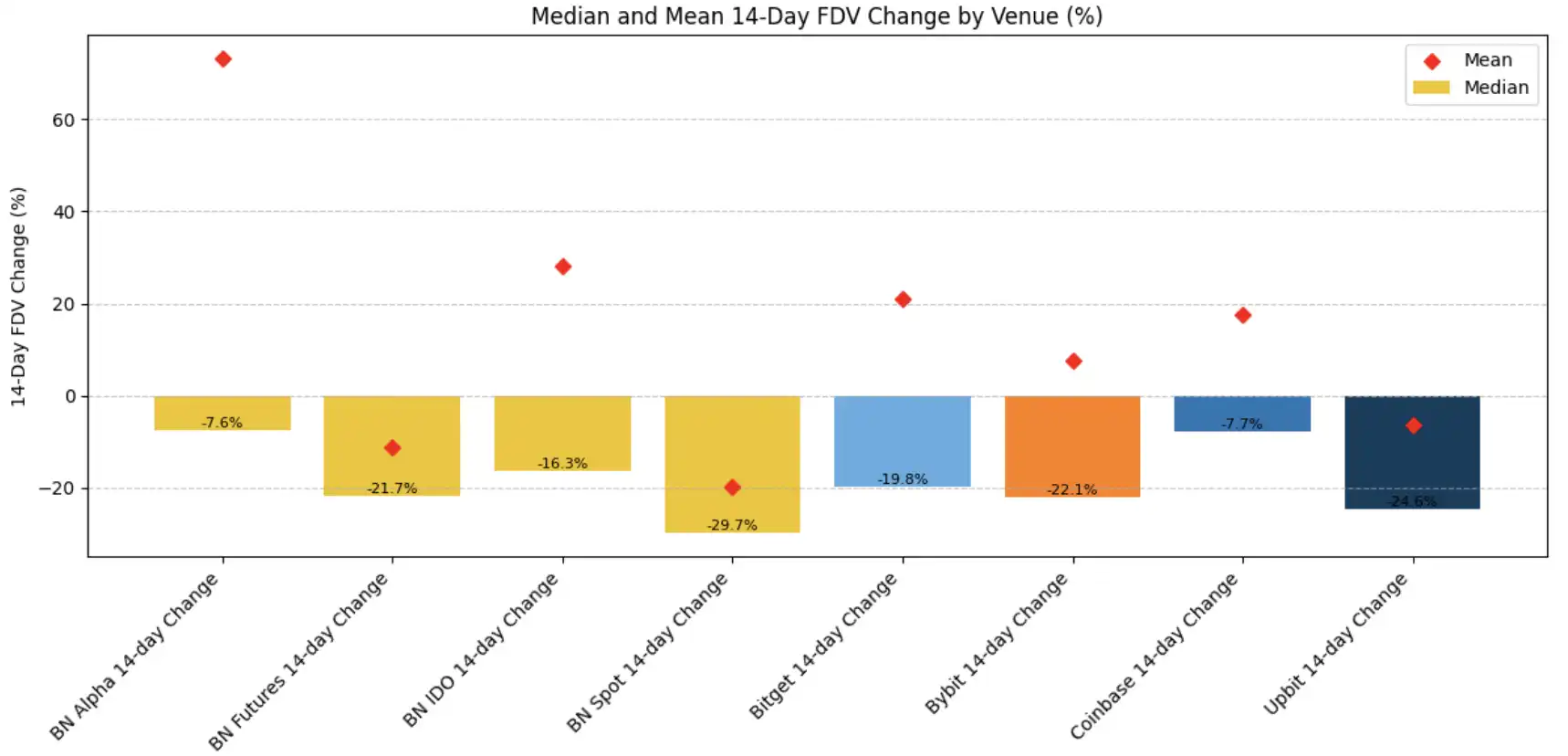
Overall, the median 14-day FDV for all platforms is negative, indicating that in the current cycle, most projects reach their valuation peak upon listing.
· Binance Alpha: average around +77%, median -7.6%. Most projects have limited returns, but a few projects experience extreme surges, showcasing Alpha's high volatility characteristics. Although performance is differentiated, the downside potential is limited, providing exposure for project teams and an asymmetric return structure for investors.
· Binance IDO and Futures: medians of -16.3% and -21.7%, but averages of +28% and -20%. This indicates that most projects perform generally, but a few projects elevate the overall average. Futures perform weaker, mainly because most projects are added after being listed for a while, past their volatility peak.
· Binance Spot: median -29.7%, average -20%. As the most prestigious platform, Spot listings may actually become exit points for early investors, leading to price pressure.
· Bitget and Coinbase: perform steadily, with Bitget's median at -19.8% and average around 21%; Coinbase's median at -7.7% and average around 18%. Both have strong capabilities in maintaining momentum after listings on Binance.
· Bybit and Upbit: perform moderately, with Bybit's median at -22.1% and average 8.9%; Upbit's median at -24.6% and average -5%. Upbit listings are usually later, with project enthusiasm having waned, resulting in weaker performance.
Surge Magnitude
Metric Definition: This section measures the ratio of the highest FDV within 14 days after listing to the listing FDV, used to assess the short-term upward potential provided by each platform.
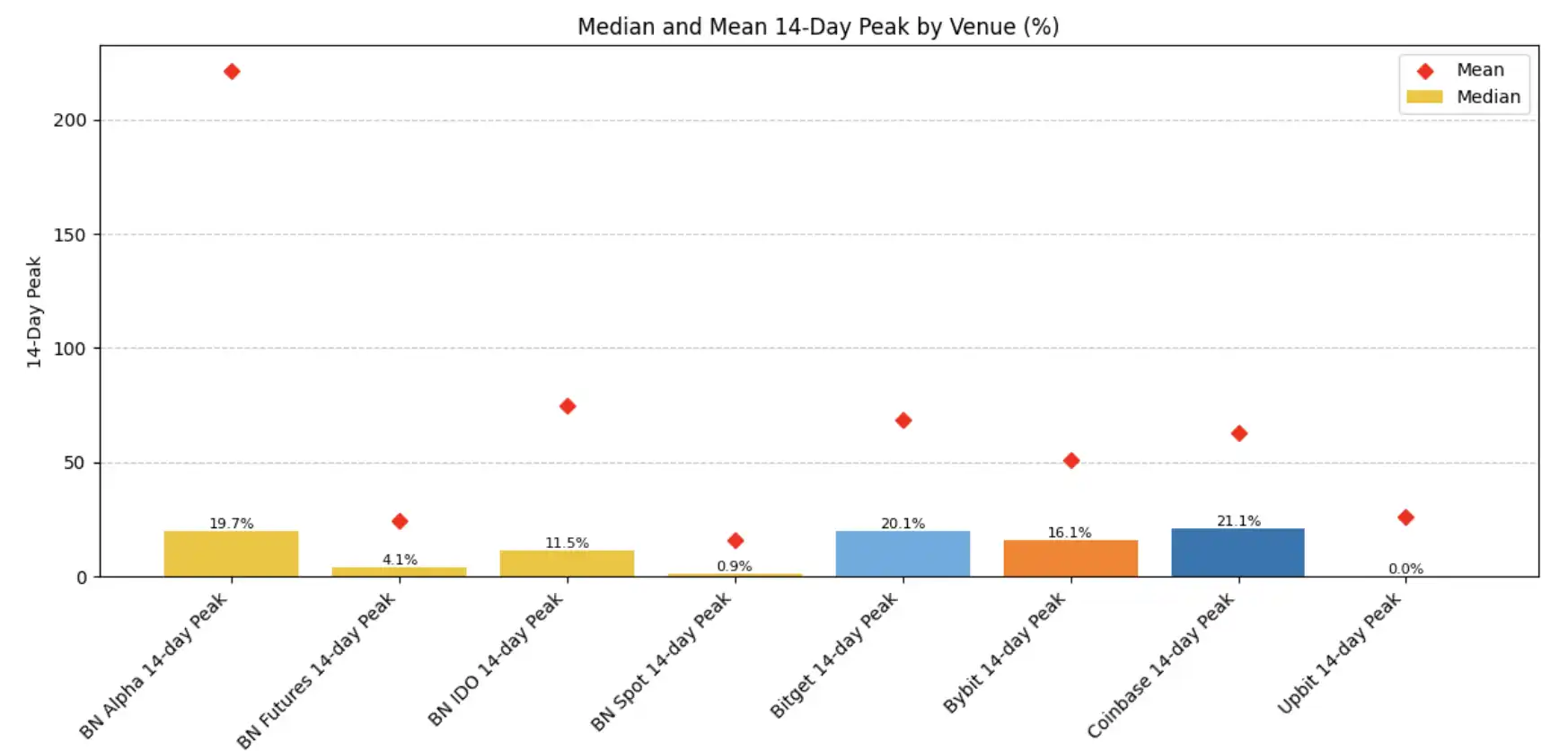
This metric helps investors gauge the upward potential of tokens in the early stages of listing while also providing project teams with a reference to understand market demand, selling pressure intensity, and each platform's price discovery capability.
· Binance Alpha: average surge magnitude reaches 220%, median 19.7%. Some projects only have slight fluctuations, but many projects experience significant increases after listing, demonstrating Alpha's strong short-term speculative nature and price discovery ability, making it the channel with the strongest upward potential among all platforms.
· Binance IDO: average surge around 75%, median 11.5%. Most projects have good speculation after listing.
· Binance Futures: average surge 27%, median only 4.1%. It has some traffic inflow, contributing to price movement, and serves as a good auxiliary exposure platform.
· Binance Spot: underperforms, with an average surge of only 15% and median 0.9%. Due to market expectations being fulfilled, projects face strong selling pressure immediately upon listing.
· Coinbase: average surge 60%, median 21.1%. It has the strongest catalytic effect among all CEXs, mainly benefiting from the U.S. user base, but with a low listing frequency.
· Bybit / Bitget: average surge 70–80%, with medians around 20%, showing a strong speculative atmosphere and noticeable short-term volatility, making them very good listing choices.
· Upbit: average surge 35%, median 0%. Trading depth is weak, and user enthusiasm is relatively limited.
II. FDV Distribution at Listing
This section starts from the FDV distribution of projects currently listed on each platform, providing path planning suggestions for project teams. Projects at different valuation stages are suitable for different listing channels, and understanding the FDV acceptance ranges of platforms helps teams more accurately match listing rhythms and platform strategies.
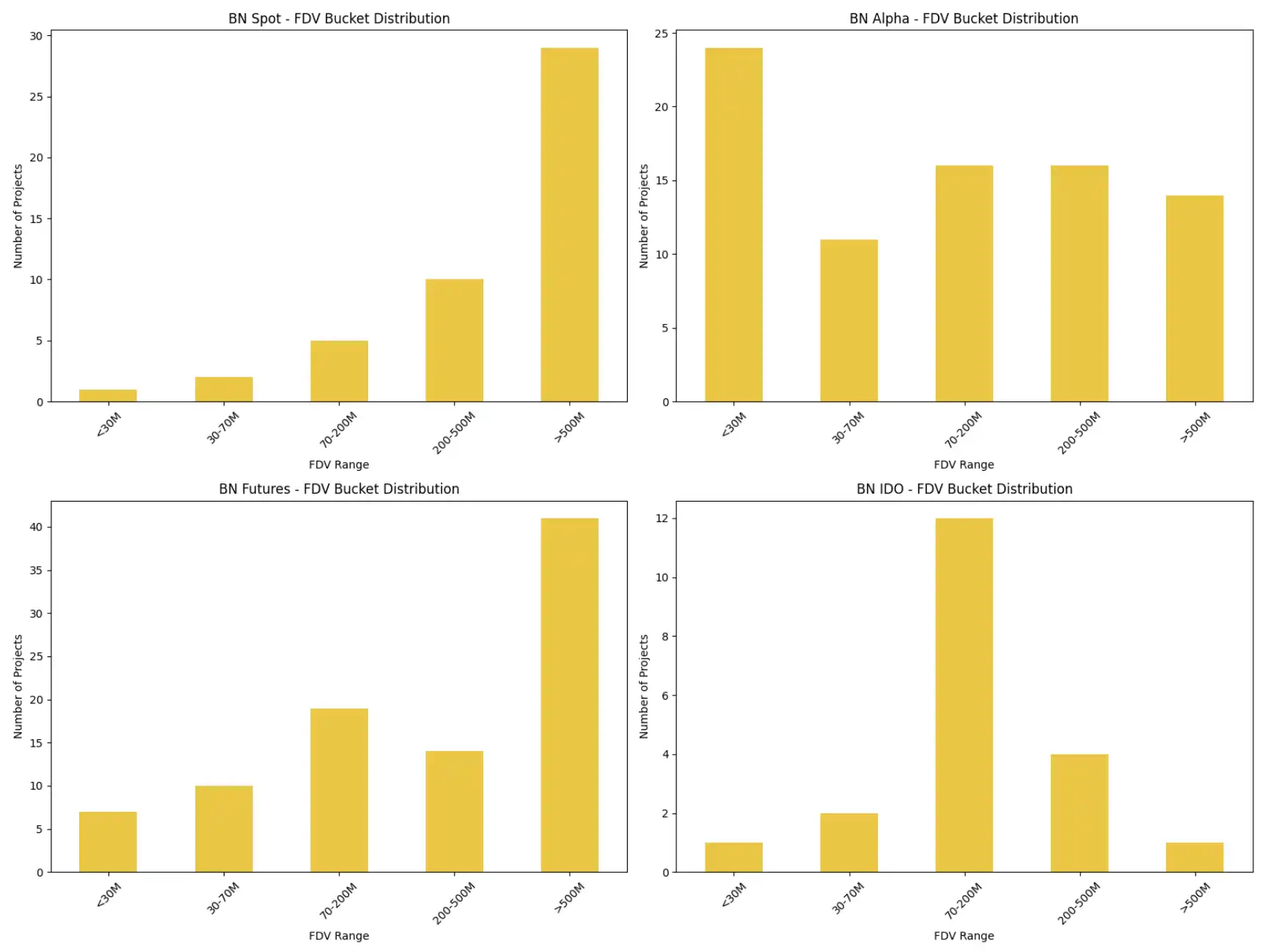
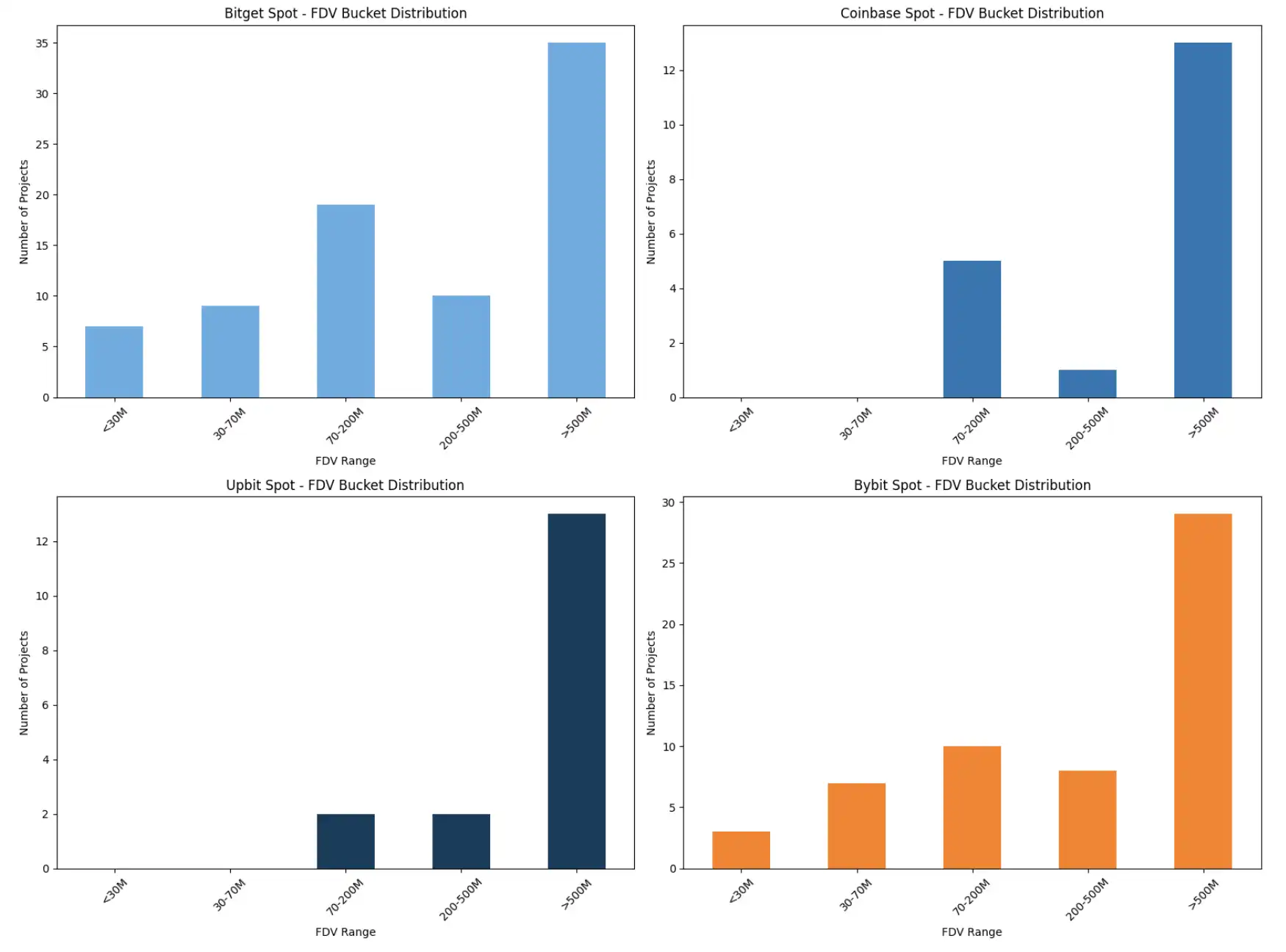
· Binance Spot: Over 60% of projects have an FDV above $500 million, showing a clear preference for large-cap projects. The platform has high requirements for project size and the background of investment institutions, making it more suitable for mature projects with established valuations.
· Binance Alpha: Covers a wide range, with FDV mostly concentrated below $200 million. This aligns with Alpha's positioning as an "experimental ground," suitable for early-stage projects with potential.
· Binance Futures: More than half of the projects have an FDV exceeding $500 million, but there is also a significant distribution in the $70 million–$500 million range. Futures serves more as a follow-up channel for already listed projects, suitable for those with relatively stable valuations.
· Binance IDO: FDV is mostly concentrated between $70 million and $200 million, indicating a preference for mid-cap projects. It is suitable for public offerings conducted after sufficient product, community, and strategy preparation.
· Bitget: Covers a complete valuation range from below $30 million to above $500 million, with a concentration in the $70 million–$200 million and above $500 million ranges. This indicates a high acceptance level on the platform, but it prefers mid to large-cap projects that already have momentum or institutional backing.
· Bybit: Nearly half of the projects have an FDV above $500 million, and there is also good coverage in the $70 million–$200 million range. It has the dual capability of accommodating short-term momentum and promoting mid-cap projects.
· Coinbase: Almost all projects have an FDV above $500 million, reflecting its compliance threshold and preference for high valuations, making the platform more suitable for mature and highly compliant projects.
· Upbit: All listed projects exceed $200 million, with most surpassing the $500 million threshold. This indicates that the Korean market has high valuation requirements, making it more suitable as a supplementary channel in later stages.
III. Platform Track Preferences
Project teams need to understand the differences in track preferences across different platforms. The following analysis focuses solely on the distribution of tracks among Binance's four major channels.
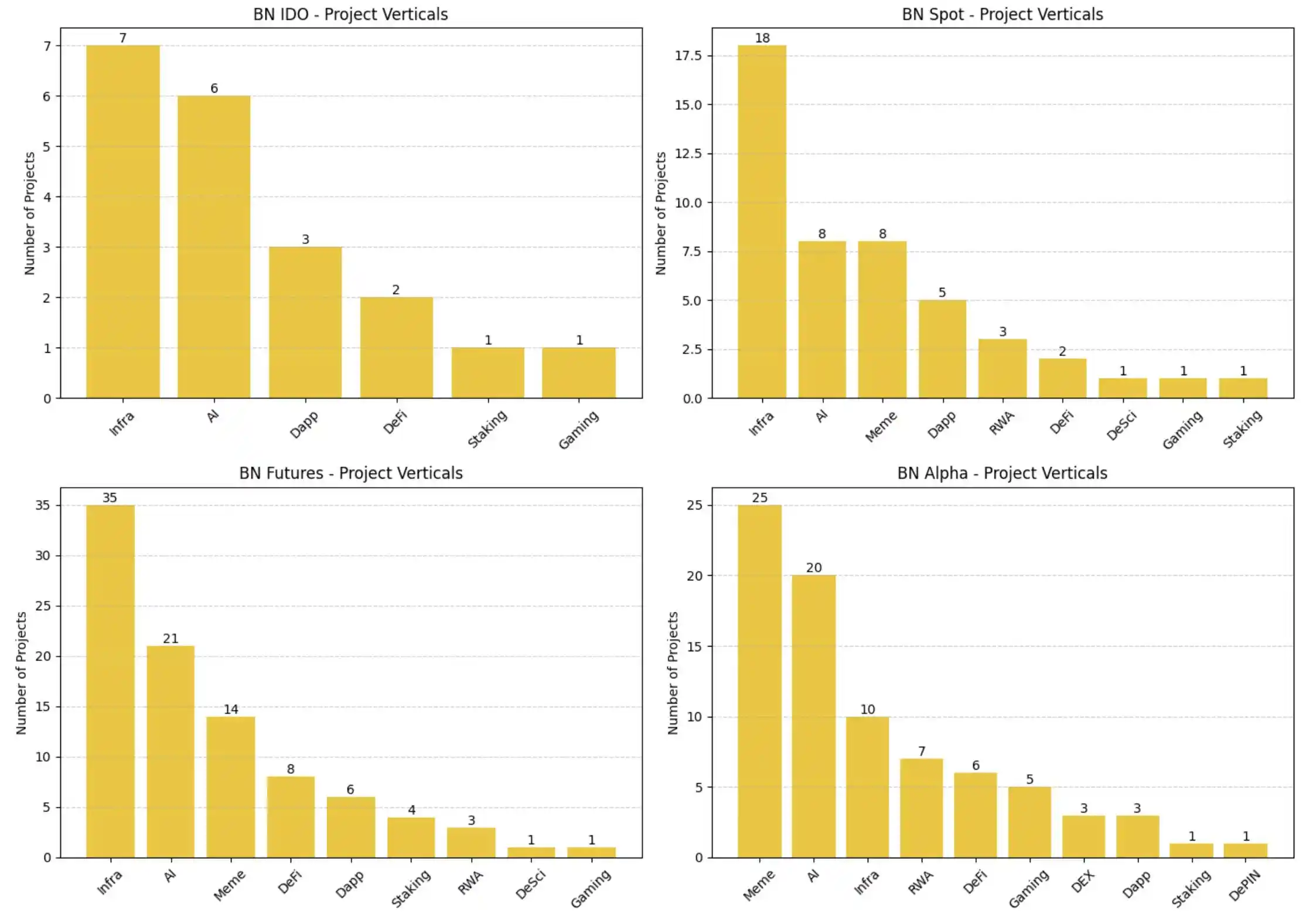
Additionally, the total number of projects listed on different channels also reflects the difficulty of listing. Generally, platforms with fewer projects have stricter selection criteria.
· Binance Spot: Approximately 50 projects listed
· Binance Futures: Approximately 90 projects listed
· Binance Alpha: Approximately 80 projects listed
· Binance IDO: Approximately 20 projects listed
Binance IDO:
· Prefers Infra (7 projects) and AI (6 projects).
· The distribution is concentrated, covering only 6 tracks.
· Clearly focuses on underlying technology and emerging application scenarios, prioritizing infrastructure and AI projects.
Binance Spot:
· Prefers Infra (18 projects), Meme (8 projects), and AI (8 projects).
· Also covers multiple subcategories such as DeFi, RWA, GameFi, Dapps, etc.
· The distribution across categories is the most balanced, but infrastructure projects still dominate.
Binance Futures:
· It is the platform with the most listed projects, covering 35 Infra and 21 AI projects.
· Meme (14) and DeFi (8) also have a significant share.
· The track coverage is broad, preferring projects that are market-active and narrative-driven.
Binance Alpha:
· Primarily focuses on Meme (25) and AI (20), highlighting speculative narratives and experimental themes.
· The number of Infra projects is 10, and it also includes RWA (5), DeFi (4), and GameFi, among others.
· Alpha serves as an experimental ground for speculative and conceptual projects.
Summary:
Project teams should adjust their product positioning and market narratives based on the track preferences of each platform.
AI projects are a popular track supported by all four channels.
Meme projects dominate in Alpha, with good coverage in Spot and Futures as well.
Infra projects are the most inclusive core track, aside from Alpha.
IV. Listing Path Analysis
Many project teams often ask a key question: Can Alpha or IDO serve as a springboard to enter Binance Spot? Let's look at the data:
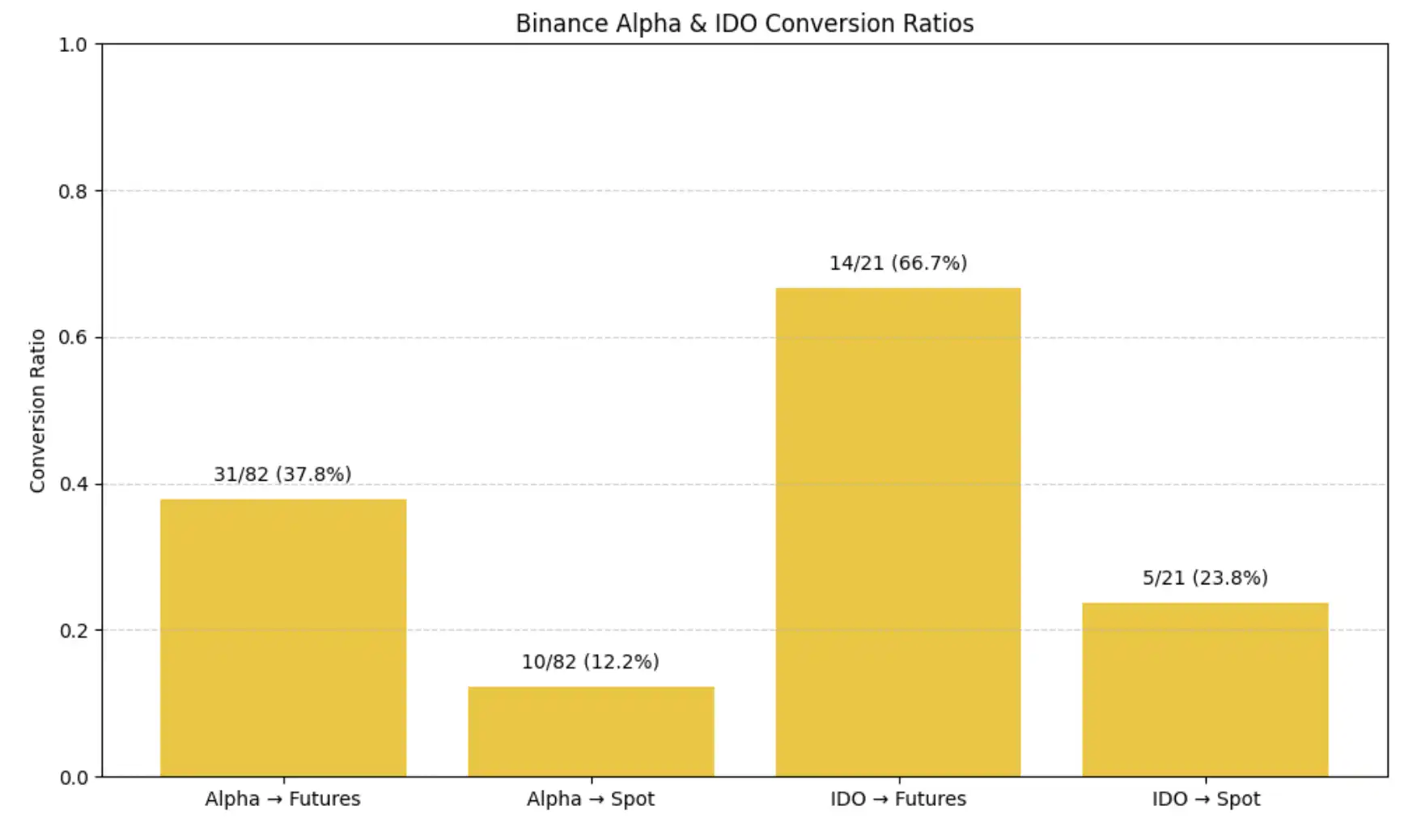
· Alpha → Futures: The conversion rate is 37.8% (31/82), making it a relatively effective preliminary channel.
· Alpha → Spot: The conversion rate is only 12.2% (10/82), which is overall low.
· IDO → Futures: The highest conversion rate, reaching 66.7% (14/21).
· IDO → Spot: The conversion rate is 23.8% (5/21), better than Alpha.
Alpha is more suitable as an early testing channel, with over 30% of projects successfully entering Futures, but to advance to Spot, strong fundamentals and market performance are still required. In contrast, IDO projects are more solid in brand recognition and community foundation, possessing higher promotion potential. Project teams should view Alpha and IDO as starting points for entering the Binance ecosystem, rather than endpoints.
Project Performance Threshold
How do projects that successfully advance from Alpha/IDO to Binance Spot perform in the early stages? Are there any patterns to learn from?
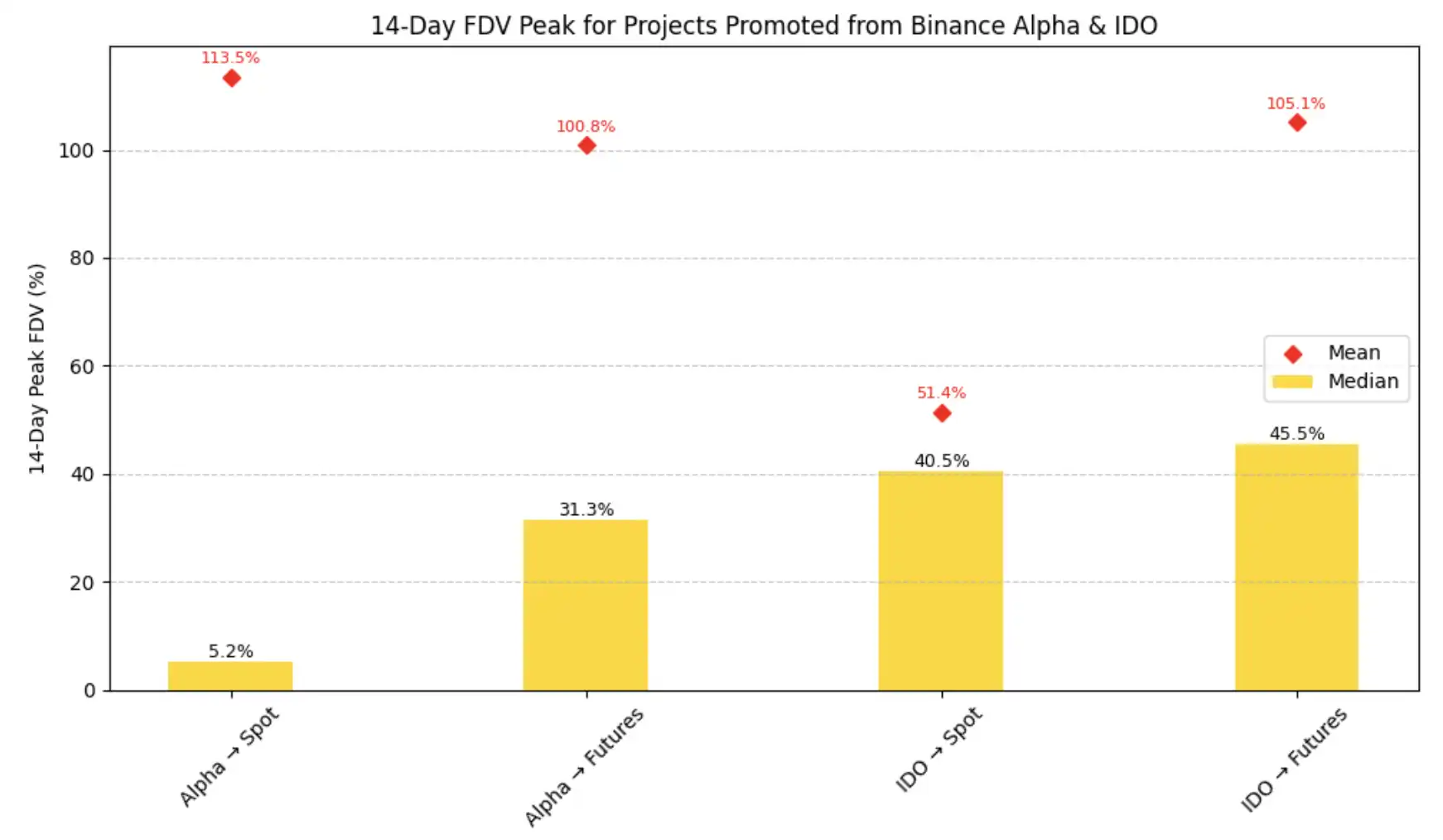
· Alpha → Spot: The median surge in FDV during the 14 days of the Alpha stage is only 5.2%, far below the 30–50% range of other paths, but its average is as high as 113.5%, the highest among all paths. This indicates significant performance differentiation, with some projects exhibiting strong explosive potential, while most have limited increases. Listing on Binance Spot does not solely rely on market speculation but places greater emphasis on product quality and hard metrics such as user data.
· The median surge for Alpha → Futures and both IDO paths (→ Spot and → Futures) is relatively concentrated, around 30–45%, with averages ranging between 51%–105%, showing stable performance.
Overall, if a project can achieve a surge of about 40–50% in FDV within two weeks after listing on a preliminary platform, it is more likely to gain further favor from Futures or Spot. This can serve as a reference standard for project teams to evaluate subsequent listing potential.
Waiting Time
Project teams also need to set reasonable expectations: how long does it typically take from Alpha or IDO to Binance Spot listing? Without a clear timeline, they may miss market windows or lose community attention.

· Alpha → Spot: The average waiting time is about 60 days, with some projects even exceeding 120 days. The overall distribution is broad, indicating that this path lacks predictability, making it more suitable as a platform for exploration rather than a direct springboard to Spot.
· Alpha → Futures: Takes an average of only 30 days, with a noticeably faster pace than Spot, demonstrating stronger market responsiveness.
· IDO → Spot and IDO → Futures: Both have an average waiting time of 17 days, with most projects completing within a month after listing. Thanks to strong community mobilization and unified rhythm arrangements, IDO projects have relatively controllable pacing in subsequent paths.
· Futures → Spot: This is the fastest among all paths, averaging only 14 days, with a highly concentrated time distribution.
If the team's goal is to quickly achieve a Binance Spot listing, Futures is currently observed to be the most certain transitional path.
V. Alternative Paths: Entering Other CEXs
Not all projects will consider Binance Spot as their only target. An increasing number of projects are turning to mainstream platforms like Bitget, Bybit, Coinbase, and Upbit after Alpha or IDO. Some platforms respond quickly and have considerable liquidity, becoming viable alternatives.
Number of Listings
After a project goes through Alpha or IDO, how many successfully enter other mainstream CEXs?
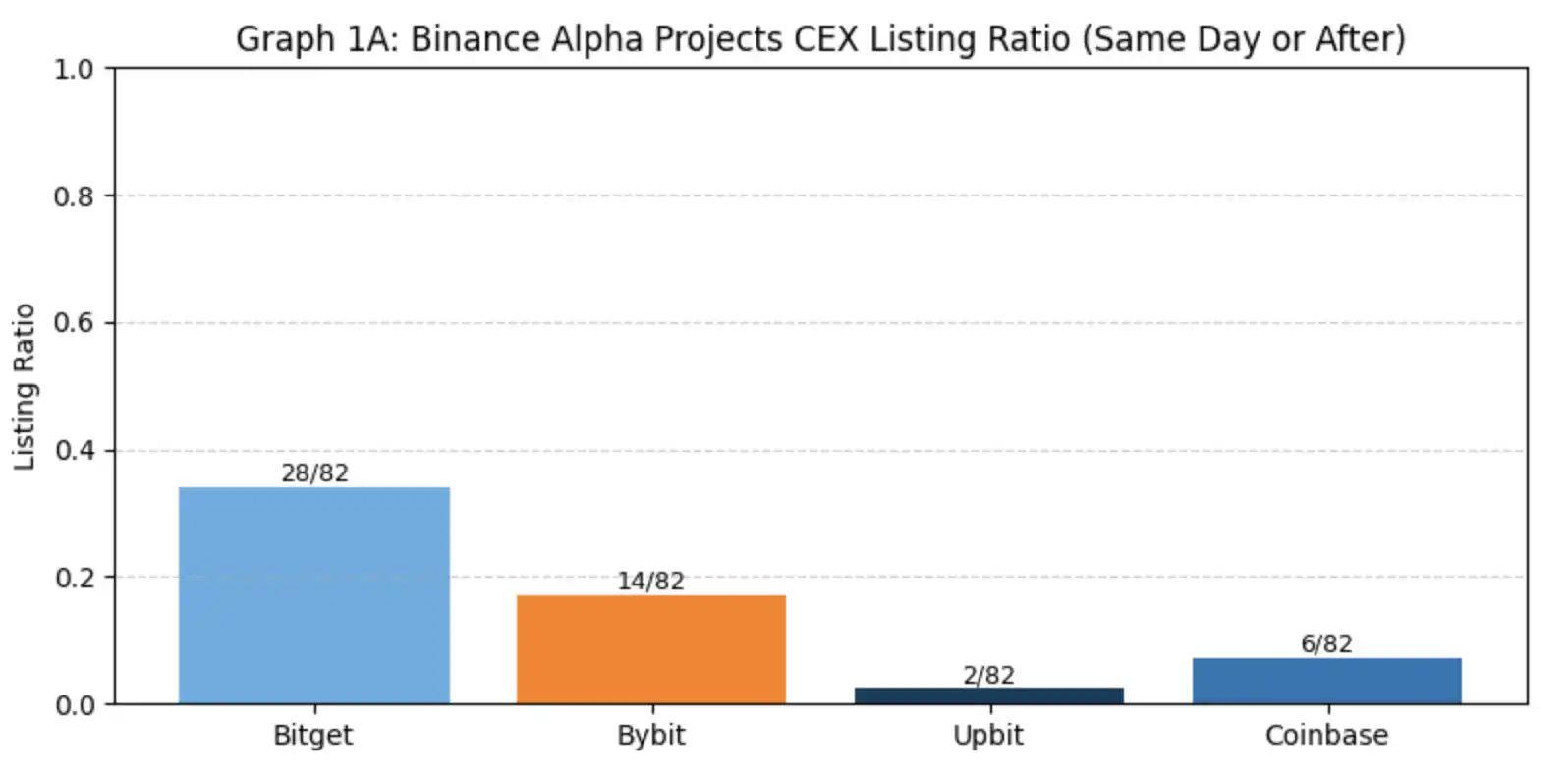

· Alpha → Bitget: The listing rate is 34.1% (28/82), far ahead. Bybit is at 17.1% (14/82), Coinbase at 6% (6/82), and Upbit has only listed 2 related projects. Bitget has the highest acceptance of Alpha projects, possibly due to its open attitude towards emerging projects and more flexible listing thresholds. Bybit also shows some interest in Alpha projects.
· IDO → Bitget and Bybit: The listing rates are 61.9% (13/21) and 47.6% (10/21) respectively, while Upbit is at 9%, and Coinbase has no records. Compared to Alpha, IDO projects are more attractive on other platforms, possibly due to their stronger brand building and community momentum. Bitget and Bybit also have a stronger capacity to accommodate IDO projects, making them important extension paths for project teams to consider.
Waiting Time for Listing
How long does it typically take for a project to follow up with a listing on mainstream CEXs after going live on Binance from Alpha or IDO?
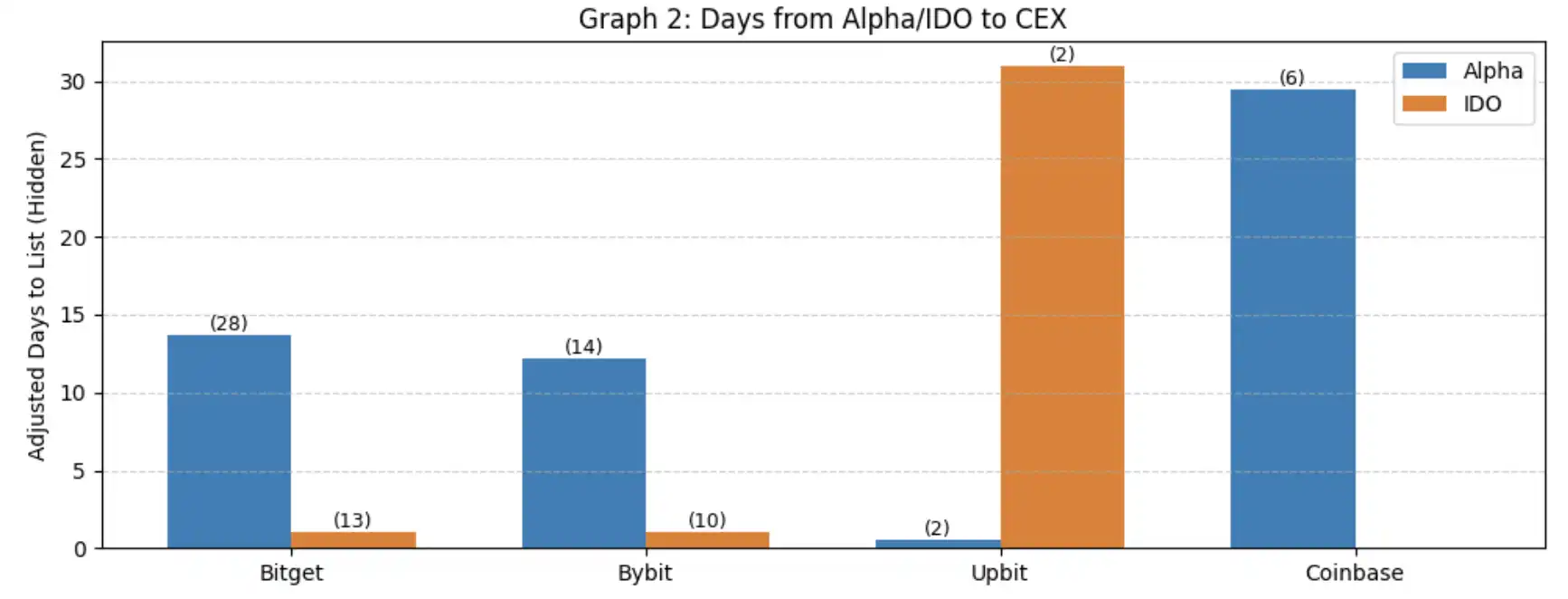
· Bitget: Alpha projects take an average of about 14 days, while IDO projects are faster, at just 13 days. Many IDO projects go live on the same day as their TGE.
· Bybit: Alpha projects take about 13 days, and IDO projects also go live on the same day as their TGE.
· Coinbase: Only lists Alpha projects, with an average of about 29 days.
· Upbit: Only lists IDO projects, with an average of about 31 days.
Bitget and Bybit have a faster pace, suitable for quick listings; Coinbase and Upbit have a slower pace, needing to align with local compliance and community rhythms.
Price Discovery Capability of Other CEXs
The following chart shows the average price increase over 14 days for Alpha and IDO projects after listing on various CEXs:
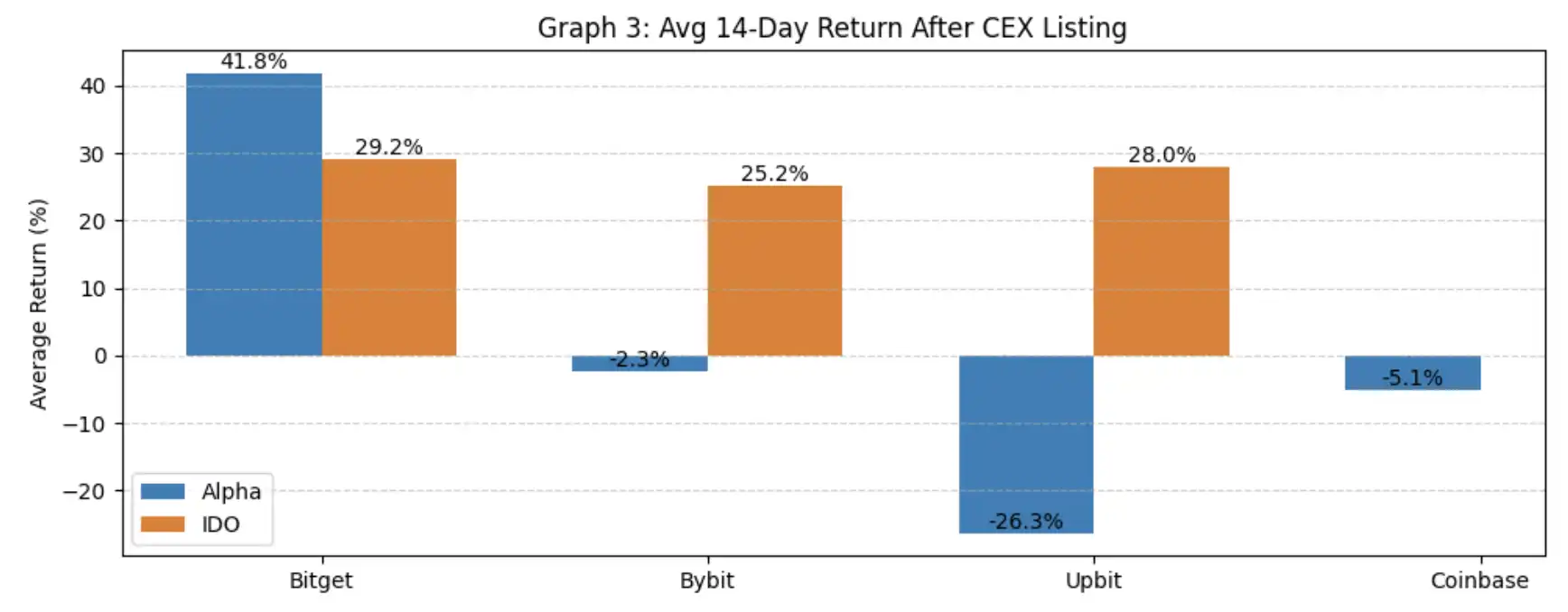
· Bitget: Alpha projects return 41.8%, while IDO projects return 29.2%, showing the best performance.
· Bybit: Alpha projects return -2.3%, while IDO projects return 25.2%, showing a preference for IDO.
· Coinbase and Upbit: The sample projects are 6 and 4 respectively, with significant statistical deviation, making them not representative.
Bitget and Bybit show stable performance in accommodating Binance projects, making them important platforms for project teams to consider when planning TGE routes.
VI. Conclusion
Overall, Binance Alpha and IDO are good preliminary platforms within Binance:
· Alpha is more like an experimental ground, with a low entry threshold, suitable for early project exposure;
· IDO has stronger brand endorsement, and the conversion rates to Futures and Spot are also higher.
However, the conversion to Spot remains relatively scarce: the final promotion rate for Alpha projects is only about 12%, and for IDO, it is only 24%. Project teams need to manage their pacing effectively:
· Alpha → Spot takes an average of about 60 days,
· IDO → Spot takes 17 days,
· Futures → Spot is the fastest, requiring only 14 days.
Additionally, the preferences of different platforms for project FDV also release key signals:
· Spot tends to favor large-cap projects with valuations above $500M;
· Alpha mainly accepts early projects with valuations below $200M;
· IDO is mostly concentrated in the $70M–$200M range, suitable for mid-sized projects with clear preparations.
Project teams should choose the appropriate channels based on their valuation stage to match liquidity expectations and market rhythms.
免责声明:本文章仅代表作者个人观点,不代表本平台的立场和观点。本文章仅供信息分享,不构成对任何人的任何投资建议。用户与作者之间的任何争议,与本平台无关。如网页中刊载的文章或图片涉及侵权,请提供相关的权利证明和身份证明发送邮件到support@aicoin.com,本平台相关工作人员将会进行核查。




